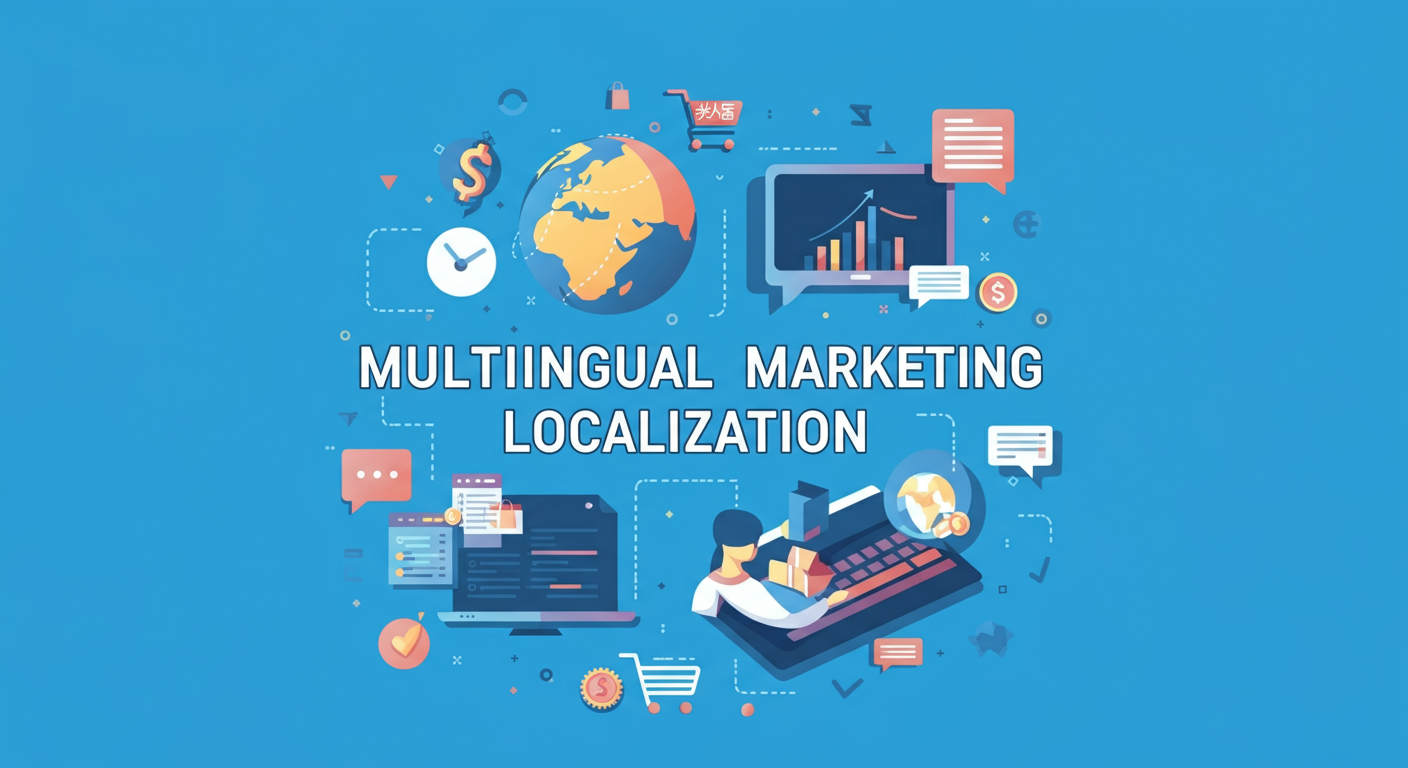
Expanding your business into international markets represents one of the most significant growth opportunities available today. However, success in global markets requires more than simply translating your marketing materials into different languages. True multilingual marketing localization involves adapting your entire marketing strategy to resonate with local cultures, preferences, and business practices.
Whether you’re planning your first international expansion or looking to improve existing multilingual campaigns, this guide provides the insights needed to navigate the complex world of global marketing successfully.
What is Multilingual Marketing Localization?

Multilingual marketing localization goes far beyond basic translation. While translation focuses on converting text from one language to another, localization adapts your marketing message to fit the cultural, social, and economic context of your target market. Learn more about effective strategies in our Local Digital Marketing Services Complete Guide.
Effective localization considers factors such as local customs, humor, color associations, imagery preferences, and even fundamental business practices. For example, a marketing campaign that works perfectly in the United States might completely fail in Japan, not because of poor translation, but because the underlying approach doesn’t align with Japanese cultural values and communication styles.
The process involves adapting everything from website design and social media content to email campaigns and advertising materials. This holistic approach ensures your brand message feels natural and relevant to each specific market rather than obviously foreign or translated.
Core Elements of Successful Multilingual Localization
Cultural Adaptation
Understanding cultural nuances forms the foundation of effective multilingual marketing. Colors, symbols, and imagery can carry vastly different meanings across cultures. Red symbolizes good fortune in China but can represent danger in Western cultures. Similarly, showing the soles of feet in marketing materials might be perfectly acceptable in some regions but highly offensive in Middle Eastern markets.
Religious considerations also play a crucial role. Marketing campaigns must respect religious holidays, dietary restrictions, and cultural sensitivities. A food company promoting pork products would need completely different approaches when entering predominantly Muslim markets compared to their strategies in Western countries.
Language Considerations
Professional translation requires native speakers who understand not just the language but also local dialects, slang, and business terminology. Machine translation tools, while improving rapidly, still struggle with context, cultural references, and emotional nuance that human translators naturally understand.
Consider regional variations within the same language. Spanish varies significantly between Spain, Mexico, and Argentina. Marketing copy that resonates perfectly with Mexican audiences might sound awkward or even confusing to Spanish consumers. Each region requires careful attention to local language preferences and communication styles.
Visual and Design Elements
Design preferences vary dramatically across cultures. Western websites typically follow left-to-right reading patterns, while Arabic and Hebrew sites require right-to-left layouts. Asian markets often prefer more information-dense designs, while Scandinavian audiences gravitate toward minimalist approaches.
Image selection requires equal attention. Photography featuring people should reflect the local population, and lifestyle imagery should align with local customs and aspirations. A luxury brand showcasing urban sophistication might need to emphasize different lifestyle elements when targeting rural markets versus metropolitan areas.
Building Your Multilingual Marketing Strategy
Market Research and Analysis
Thorough market research forms the cornerstone of successful multilingual marketing localization. This involves understanding not just demographic data but also cultural preferences, competitive landscapes, and local marketing practices.
Analyze how successful local and international brands communicate in your target markets. Identify patterns in messaging, visual design, and campaign approaches that resonate with local audiences. This research phase should also uncover cultural taboos, sensitive topics, and communication preferences that could impact your marketing effectiveness.
Consumer behavior research reveals how different cultures interact with brands, make purchasing decisions, and prefer to receive marketing messages. Some cultures value detailed product information and specifications, while others respond better to emotional storytelling and brand personality.
Platform and Channel Selection
Marketing channel effectiveness varies significantly across different markets. While Facebook might dominate social media usage in the United States, platforms like WeChat in China, Line in Japan, or VKontakte in Russia hold larger market shares in their respective regions.
Email marketing acceptance and effectiveness also differ by culture. Some markets embrace promotional emails, while others view them as intrusive. Understanding these preferences helps allocate marketing budgets more effectively and avoid wasting resources on ineffective channels.
Consider local search engines as well. Google dominates most Western markets, but Baidu holds the majority share in China, and Yandex leads in Russia. Your SEO and paid search strategies must adapt to these platform differences.
Content Creation and Management
Developing localized content requires creating materials that feel authentically local rather than translated. This might involve completely rewriting marketing copy to align with local communication styles, humor, and cultural references.
Content calendars must account for local holidays, cultural events, and seasonal patterns that might differ from your home market. A retail brand’s holiday marketing timeline would need significant adjustments when expanding from the United States to markets that don’t celebrate Thanksgiving or have different Christmas traditions.
User-generated content strategies also require localization. The types of content customers create and share vary by culture, as do privacy preferences and social media usage patterns.
Technology and Tools for Multilingual Marketing
Translation Management Systems
Modern translation management systems streamline the localization process by organizing content, managing translator workflows, and maintaining consistency across multiple markets. These platforms often include terminology databases that ensure consistent use of brand-specific terms and technical vocabulary across all markets.
Integration capabilities allow these systems to connect with content management systems, making it easier to manage multilingual websites and marketing materials. Version control features help track changes and updates across multiple language versions. For more on optimizing your digital presence, visit our guide on Local Search Marketing Services.
Marketing Automation Platforms
Sophisticated marketing automation platforms now offer multilingual capabilities that allow marketers to create targeted campaigns for different language groups and geographic regions. These tools can automatically segment audiences based on language preferences and location while tracking engagement across different cultural groups.
Personalization features enable dynamic content that adapts not just to individual preferences but also to cultural contexts. A global e-commerce site might automatically adjust product recommendations, pricing displays, and promotional messaging based on the visitor’s location and language settings.
Analytics and Measurement Tools

Measuring success across multilingual campaigns requires analytics tools that can segment data by language, region, and cultural factors. Standard metrics like click-through rates and conversion rates might perform differently across cultures, making it important to establish region-specific benchmarks.
Cultural factors can influence how audiences interact with marketing materials. Some cultures might prefer researching extensively before making purchases, leading to longer sales cycles but higher ultimate conversion rates. Others might make quicker decisions but have higher return rates.
Common Pitfalls and How to Avoid Them
Translation Errors and Cultural Missteps
Even major brands have suffered embarrassing translation failures that damaged their reputation in new markets. Kentucky Fried Chicken’s “finger-lickin’ good” slogan reportedly translated to “eat your fingers off” in Chinese markets. While this particular example might be apocryphal, similar real-world mistakes highlight the importance of professional, culturally aware translation.
Beyond obvious translation errors, subtle cultural missteps can undermine marketing effectiveness. Humor rarely translates directly across cultures, and attempts at clever wordplay often fall flat or even offend in different linguistic contexts. Working with local cultural consultants helps identify these potential issues before campaigns launch.
Inconsistent Brand Messaging
Maintaining brand consistency while adapting to local markets creates an ongoing challenge. The key lies in identifying core brand values and personality traits that remain constant while allowing flexibility in how these elements are expressed across different cultures.
Develop brand guidelines that specify which elements must remain consistent globally and which can be adapted locally. Your brand’s commitment to quality might be universal, but the way you communicate that commitment could vary significantly between markets that value technical specifications versus those that prefer emotional appeals.
Inadequate Local Market Understanding
Assuming that successful marketing strategies will work universally often leads to expensive failures. Each market has unique competitive dynamics, regulatory requirements, and consumer expectations that require specific approaches.
Invest in local market expertise, either through hiring regional specialists or partnering with local agencies that understand cultural nuances and market conditions. This local knowledge proves invaluable for avoiding costly mistakes and identifying opportunities that might not be obvious to outsiders.
Measuring Success in Multilingual Marketing
Key Performance Indicators
Establishing appropriate KPIs for multilingual marketing requires understanding how cultural factors influence consumer behavior and purchasing patterns. Standard metrics like website traffic, engagement rates, and conversion rates remain important, but their interpretation might vary significantly across markets.
Consider cultural factors that influence these metrics. Markets with high uncertainty avoidance might show longer consideration periods but higher conversion rates once trust is established. Understanding these patterns helps set realistic expectations and identify successful campaigns.
ROI Analysis Across Markets
Calculating return on investment for multilingual marketing campaigns involves more than simple revenue tracking. Different markets might have varying customer lifetime values, acquisition costs, and seasonal patterns that affect short-term and long-term profitability.
Factor in the total cost of localization, including translation, cultural adaptation, local market research, and ongoing management. Some markets might show lower initial returns but offer greater long-term growth potential or strategic value for further expansion.
Taking Your Global Marketing to the Next Level
Successful multilingual marketing localization requires commitment, resources, and patience. The investment in properly understanding and adapting to local markets pays dividends through stronger brand connections, higher conversion rates, and sustainable competitive advantages.
Start with thorough market research and cultural understanding before developing your localization strategy. Invest in professional translation and cultural consultation services, and choose technology platforms that support multilingual marketing efforts effectively.
Remember that localization is an ongoing process rather than a one-time project. Markets evolve, cultural preferences shift, and competitive landscapes change. Regular review and optimization of your multilingual marketing efforts ensures continued success as you expand into new markets and deepen your presence in existing ones.
Begin by selecting one or two priority markets for initial expansion, developing comprehensive localization strategies for these regions before scaling to additional markets. This focused approach allows you to refine your processes and build expertise that will benefit future expansion efforts.
Leave a Reply